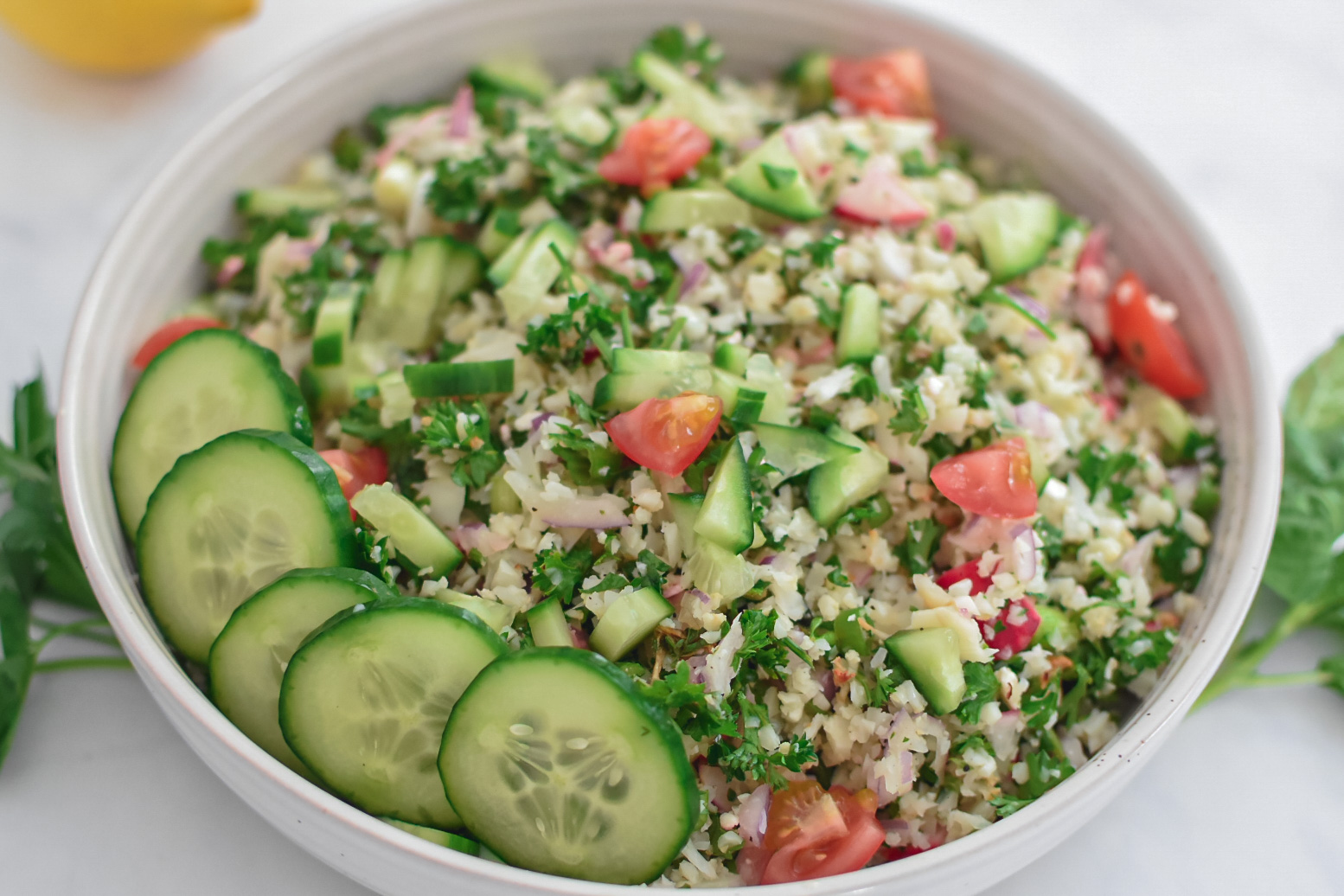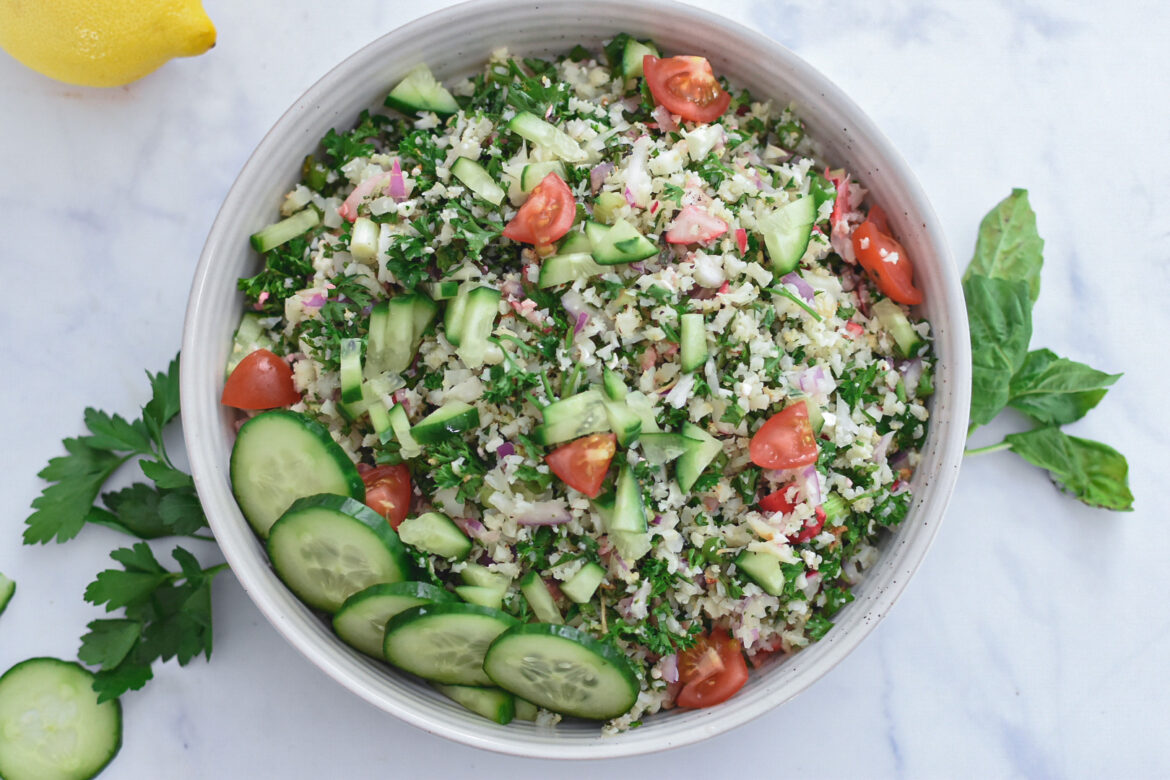Tabbouleh Salad (also known as Tabouli) is a refreshing Lebanese side dish, full of herbs and lemony goodness. This cauliflower version swaps out the traditional bulgur for cauliflower, adding more veggies for a healthier twist. Enjoy it on its own or over a bed of lettuce!
If you’ve ever dined at a Middle Eastern or Mediterranean restaurant, you’ve probably seen Tabbouleh (or Tabouli) on the menu. Traditionally served alongside hummus, pita, and feta, it’s a refreshing and flavorful dish you won’t want to miss.
This Cauliflower Tabbouleh Salad takes the classic to the next level by swapping bulgur for riced cauliflower, creating a delicious, low-carb alternative that’s just as easy to make and enjoy!

What is Tabbouleh Salad?
Tabbouleh (or Tabouli) is a beloved Lebanese dish that’s packed with fresh herbs, lemony flavors, and wholesome ingredients. Traditionally made with bulgur, this herb salad is a staple in Middle Eastern cuisine, often served with hummus, pita, and feta.
In this Cauliflower Tabbouleh Salad recipe, we replace bulgur with riced cauliflower for a low-carb, gluten-free twist. Whether you’re following a specific diet or just love the taste of cauliflower, this fresh, vibrant dish is a winner!
Why Make Cauliflower Tabbouleh?
Switching bulgur for cauliflower isn’t just about cutting carbs—it’s about elevating the dish with even more vegetables. By using cauliflower rice, this salad becomes versatile enough to serve as a main dish, not just a side.
This Mediterranean-inspired recipe is perfect for meal prep, as the flavors deepen and improve over time. Whether you’re pairing it with grilled chicken, hummus wraps, or pita bread, cauliflower tabbouleh will bring bright, zesty flavors to your table.

Ingredients You’ll Need to Make Cauliflower Tabbouleh Salad
Cauliflower – The base for this low-carb twist on tabbouleh, riced cauliflower mimics the texture of bulgur, making it a great veggie-packed alternative.
Olive oil – Adds richness and helps coat the veggies, giving the salad a smooth texture and depth of flavor.
Fresh lemon juice – The zesty and tangy element that brightens the salad, giving it a fresh, citrusy kick.
Lemon zest – Intensifies the lemon flavor and adds a fragrant, aromatic note to the dressing.
Radishes – These add a crunchy texture and a slight peppery bite, balancing the fresh herbs and citrus.
Scallions – With their mild onion flavor, they bring freshness and crunch to the salad.
Red onion – Adds a sharp, slightly sweet flavor, enhancing the complexity of the salad. Soaking it in water can reduce bitterness.
Garlic – A savory addition that brings depth and warmth to the salad’s flavor profile.
Italian parsley – The star herb of tabbouleh, parsley provides fresh, bright flavors and a pop of color.
Mint (optional) – Adds a cool, refreshing flavor that complements the lemon and parsley.
English cucumber – Offers crispness and a light, refreshing flavor, making the salad even more refreshing.
Grape tomatoes – Sweet and juicy, these tomatoes provide bursts of flavor that perfectly balance the crunchy vegetables.
Kosher salt – Enhances all the flavors, drawing out the freshness of the ingredients and rounding out the dressing.
Black pepper – A pinch adds a subtle heat that balances the acidity of the lemon juice and the freshness of the herbs.

Tips for Making the Best Cauliflower Tabbouleh Salad
Finely chop parsley: Smaller pieces absorb the dressing better.
Adjust seasoning: Add more olive oil or lemon juice to suit your taste.
Avoid overcooking: Keep the cauliflower firm to maintain texture.
Soften red onions: Soak in water to reduce bitterness.
How to Serve Cauliflower Tabbouleh Salad
- With hummus and pita for a light meal.
- As a topping for wraps or grain bowls.
- Paired with grilled meats or falafel.
- On top of salads, in wraps, or just by itself!
Other Salad Recipes We Think You’ll Love
If you loved this Cauliflower Tabbouleh Salad, don’t forget to leave a 5-star 🌟🌟🌟🌟🌟 rating in the recipe card below! We’d love to hear from you—leave a comment to let us know how you enjoyed it!

Cauliflower Tabbouleh Salad
Equipment
- Food processor
Ingredients
- 1 medium head of cauliflower
- 4 tablespoon olive oil, divided
- 1/4 cup freshly squeezed lemon juice
- 1 teaspoon fresh lemon zest, (see notes)
- 8 radishes, thinly sliced and chopped
- 1 bunch scallions finely chopped
- 1/4 cup red onion, minced
- 1 teaspoon garlic, minced
- 3 cups Italian (curly) parsley, chopped
- 1 tablespoon mint, finely chopped (optional, see notes)
- 1 English cucumber, finely chopped
- 1 pint grape tomatoes, sliced in half or quarters
- 1 teaspoon Diamond Crystal kosher salt
- 1/4 teaspoon pepper, more to taste
Instructions
- Prepare the Cauliflower: Heat your oven to 375°F with a rack positioned in the center. Line a large baking sheet with foil and spray with non-stick spray. Wash and cut the cauliflower into large chunks. Toss with 1 tablespoon of olive oil, then spread evenly on the prepared baking sheet. Bake for about 20 minutes, or until barely tender. Take care not to overcook.
- Cool and Process: Let the roasted cauliflower cool for about 20 minutes. Transfer it to a food processor and pulse until it reaches a rice-like texture. Work in batches if needed, and avoid over-processing to prevent it from becoming mushy.
- Assemble the Salad: In a large bowl, combine the processed cauliflower, radishes, scallions, red onion, garlic, parsley, mint (if using), cucumber, and tomatoes.
- Dress the Salad: Drizzle with the remaining 3 tablespoons of olive oil, lemon juice, lemon zest, salt, and pepper. Toss everything together until well combined.
- Chill and Serve: Cover the bowl with plastic wrap or transfer the salad to an airtight container. Refrigerate for at least 1 hour to allow the flavors to meld. This salad can be stored in the fridge for up to 5 days.
Notes
- Salt: If using Morton's Kosher Salt, reduce the amount to half (about 1/2 teaspoon) since it's saltier than Diamond Crystal.
- Lemon Zest: When zesting, only use the yellow part of the peel as the white pith is bitter. If you don’t have a zester, skip it and add a bit more lemon juice instead.
- Mint: Fresh mint is optional and can be replaced with 1 teaspoon of dried mint if unavailable. Adjust to taste.

